Dedicated to information and material related to the history of botany particularly in the 19th and 20th century English speaking world. If you have contributions of interest to post, please contact me at the email address on the left of this page.
Wednesday, June 30, 2004
History in the Making
A little off topic, but worth mentioning just the same. The University of Connecticut's titan arum (Amorphophallus titanum) "Corpse Flower" appears ready to bloom today or tomorrow. There is a live webcam on the plant. Witness this special event by keeping an eye on THIS LINK for the next few days.
Monday, June 28, 2004
"Name That Botanist" Series
Join the fun! I will periodically post photos or other likenesses of bygone botanists (both famous and not-so-famous) from my collection. There will be a link under each image identifying the subject. See how many can you get recognize! As always, feel free to email me for comments, suggestions, criticisms etc. Number 1 in the series starts today. Give it a try!
Number 1 - Name That Botanist
Thursday, June 24, 2004
19th Century Class Tickets
The modern day practice of registration for medical courses did not exist as such in the nineteenth century. Rather than a registrar, the professor at a medical school issued each of his students an admission ticket for his class upon payment of the fee. The more popular professors commanded higher tuitions. As can be seen, this was the practice on both sides of the Atlantic. Because botany was of such importance to materia medica and therapeutics, many botanists had been trained as physicians and often taught at medical schools. Some of their tickets survive to remind us of their academic careers. They often bear the professor's signature as well as the name of the student - occasionally a young scholar destined to achieve future prominence in his own right. Here is a sampling of such tickets which I have been able to acquire. Professor Hadley's ticket is included for two reasons. Hadley, who was at the College of Physicians and Surgeons of the Western District of the State of New York in Fairfield, was Asa Gray's mentor and is credited with having promoted Gray's development in natural history during his early years as a medical student at Fairfield. This ticket was issued by Hadley to Gray's close chum, botanizing companion and medical school classmate (one year Gray's junior), Nathan Wright Folwell of Ovid, New York.

John Torrey
Click on image to enlarge

John Lindley
Click on image to enlarge

John Hutton Balfour
Click on image to enlarge

David Hosack
Click on image to enlarge
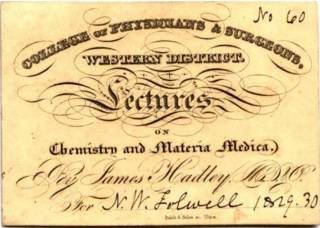
James Hadley
Click on image to enlarge

Theodric Romeyn Beck
Click on image to enlarge

John Lang Cassels
Click on image to enlarge

John Torrey
Click on image to enlarge

John Lindley
Click on image to enlarge

John Hutton Balfour
Click on image to enlarge

David Hosack
Click on image to enlarge

James Hadley
Click on image to enlarge

Theodric Romeyn Beck
Click on image to enlarge

John Lang Cassels
Click on image to enlarge
Tuesday, June 22, 2004
Bookplates of Botanists
Bookplates of notable botanists can be fascinating to study as well as being miniature works of art. They can be a pictograph of the interests and experiences of the individual. Here is a sampling of some bookplates of important figures in the history of botany that were found in books I have collected.
I want to acknowledge Ed Cobb and Professor William Crepet at Cornell University for their expertise and assistance in identifying the plants depicted.
Professor Crepet recognized the Ceropegia in Arthur Allman Bullock's plate. He is associated with this genus; his first asclepiad paper was the publication of the East African species Ceropegia filicalyx (1933). He dealt with the entire genus in the 1955 Kew Bulletin. My "thank you" to Dr. Peter Bruyns who has identified the spiecies as C. stapeliiformis.
Ed observes jack-in-the-pulpit (Arisaema triphyllum) with some fern crosiers at the bottom on Billington's.
If you can translate the Naxi hieroglyphs on Professor Rock's, please let me know. The central Chinese characters translate simply to "Dr. (in the Ph.D. sense) Rock; his stamp". They are embossed and palpable on the surface of the paper.
Probably Yosemite with Sequoia gigantea on Harvey Hall's, who, with wife Carlotta, wrote A Yosemite Flora (1912).
Plants on Bessey's plates are a bit more stylized and generalized, but good suggested bets (by Ed Cobb again) are as follows: At eleven o'clock position -Robinia ?pseudoacacia (black locust); At one o'clock position - Gleditsia tricanthos (honey locust); At five o'clock position - Carya laciniosa (shellbark hickory); At seven o'clock position - Aristolochia macrophylla (Dutchman's pipe); At nine o'clock position- Fagus grandifolia (American beech). I don't find that Bessey had any special interest or publications on these, but if you have further suggestions please email me!
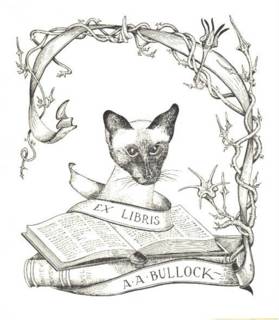
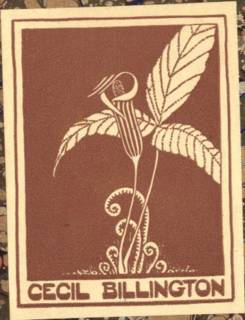
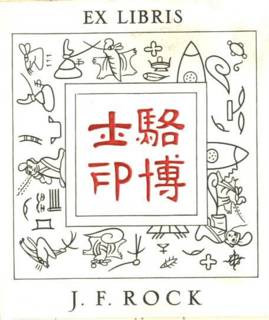
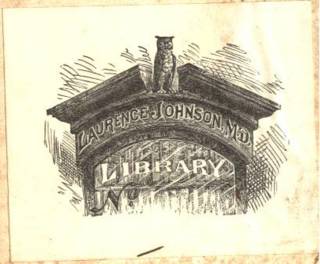
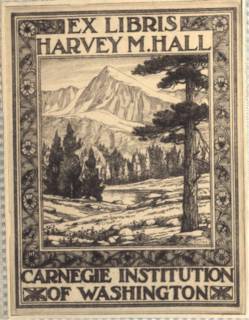

Hugo De Vries
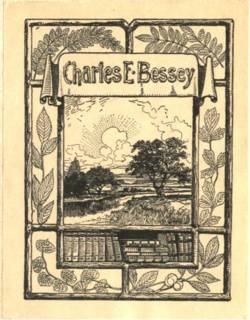
I want to acknowledge Ed Cobb and Professor William Crepet at Cornell University for their expertise and assistance in identifying the plants depicted.
Professor Crepet recognized the Ceropegia in Arthur Allman Bullock's plate. He is associated with this genus; his first asclepiad paper was the publication of the East African species Ceropegia filicalyx (1933). He dealt with the entire genus in the 1955 Kew Bulletin. My "thank you" to Dr. Peter Bruyns who has identified the spiecies as C. stapeliiformis.
Ed observes jack-in-the-pulpit (Arisaema triphyllum) with some fern crosiers at the bottom on Billington's.
If you can translate the Naxi hieroglyphs on Professor Rock's, please let me know. The central Chinese characters translate simply to "Dr. (in the Ph.D. sense) Rock; his stamp". They are embossed and palpable on the surface of the paper.
Probably Yosemite with Sequoia gigantea on Harvey Hall's, who, with wife Carlotta, wrote A Yosemite Flora (1912).
Plants on Bessey's plates are a bit more stylized and generalized, but good suggested bets (by Ed Cobb again) are as follows: At eleven o'clock position -Robinia ?pseudoacacia (black locust); At one o'clock position - Gleditsia tricanthos (honey locust); At five o'clock position - Carya laciniosa (shellbark hickory); At seven o'clock position - Aristolochia macrophylla (Dutchman's pipe); At nine o'clock position- Fagus grandifolia (American beech). I don't find that Bessey had any special interest or publications on these, but if you have further suggestions please email me!






Hugo De Vries

Friday, June 18, 2004
The Frost Flower
Here is a fun exchange between Dr. Edwin Moses Hale, M.D. (1829-1899) and Asa Gray. Based upon the dateline, it must have taken place sometime after 1863, the year in which Hale came to Chicago (from Michigan). The "A.G."-initialled, one sentence comment at the bottom is in Asa Gray's hand. I found both the letter and newsclipping in Hale's copy of Matthias Jakob Schleiden's Poetry Of The Vegetable World (1853), edited by Alphonso Wood (Moore, Anderson, Wilstach & Keys, Cincinnati). This book is of some interest in the history of American textbooks of botany. Emanuel D. Rudolph has studied it (see pages 48-58 of Emanuel D. Rudolph's Studies in the History of North American Botany edited by Ronald L. Stuckey and William R. Burk, SIDA, Botanical Miscellany, No. 19, Botanical Research Institute of Texas, 2000; ISBN 1-889878-05-7).
Edwin Moses Hale to Asa Gray
Click on image to enlarge
124 Clark St.
Chicago, June 13
Prof. A. Gray:
Dear Sir:
I cut the enclosed from a newspaper a month or two ago. I have a suspicion that it is a hoax *, but my curiosity is such that I would like to have you give me your opinion or knowledge concerning it.
Yours truly,
E.M. Hale,
Prof Med. Bot. et Mat. Med.
* Yes, and a neat and amusing one!
A.G.
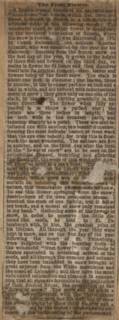
The Frost Flower Newspaper Clipping
Click on image to enlarge
The Frost Flower.
A Boston journal describes an extraordinary “frost flower” of Russia, which has been produced, it is said, in Boston in a temperature of artificial cold, in the following words: This wonderful plant, or rather flower, is found only on the northern boundaries of Siberia, where the snow is eternal. It was discovered in 1853 by Count Swinoskoff, the eminent Russian botanist, who was ennobled by the czar for his discovery. Bursting from the frozen snow on the first day of the year, it grows to the height of three feet and flowers on the third day, remains in flower for 24 hours and then dissolves itself into its original element – stem, leaves and flowers being of the finest snow. The stalk is about 1 inch in diameter; the leaves, three in number, in the broadest part are an inch and a half in width, and are covered with infinitessimal cones of snow; they grow only on one side of the stalk, to the north, curving gracefully in the same direction. The flower when fully expanded is in shape a perfect star; the petals are three inches in length, half an inch wide in the broadest parts, and tapering sharply to a point. These are also interlaced one with another, in a beautiful manner, forming the most delicate basket of frost work that the eye ever beheld; for truly this is a frost-work the most wonderful. The anthers are five in number, and on the third day after the birth of the “flower of snow” are to be seen on the extremities thereof, trembling and glittering like diamonds, the seeds of this wonderful flower, about as large as a pin’s head. The ??? botanist says that when first he beheld this flower “I was dumb with astonishment; filled with wonderment, which gave way to interest (?) most ecstatic on beholding this wonderful work of nature, this remarkable phenomenon of snow, To see this flower springing from the snowy desert – born of its own composite atoms. I touched the stem of one lightly, but it fell at my touch, and a morsel of snow only remained in my hand.” Gathering some of the flowers in snow, in order to preserve the little diamond like seeds, he hied to St. Petersburgh with, to him, the greatest prize of his lifetime. All through the year they were kept in snow, and on the first day of the year following the court of St. Petersburg, were delighted with the bursting forth of the wonderful “frost flower!” Our friend in Boston succeeded in obtaining several of the seeds, and all through the summer and autumn they have been embedded in snow brought at great expense from the White mountains and the coast of Labrador; and they have the most unbounded satisfaction and pleasure in announcing that all signs are favorable to the realization of their fondest hopes, the production of the “flower of snow.” The snow and ice are in a large glass refrigerator, with the thermometer 45 degrees below zero, and the solid bed of snow has already begun to show little fissures and a slight parting (?) in the centre; unmistakable evidence of the forthcoming of the phenomenon.

Edwin Moses Hale to Asa Gray
Click on image to enlarge
124 Clark St.
Chicago, June 13
Prof. A. Gray:
Dear Sir:
I cut the enclosed from a newspaper a month or two ago. I have a suspicion that it is a hoax *, but my curiosity is such that I would like to have you give me your opinion or knowledge concerning it.
Yours truly,
E.M. Hale,
Prof Med. Bot. et Mat. Med.
* Yes, and a neat and amusing one!
A.G.

The Frost Flower Newspaper Clipping
Click on image to enlarge
The Frost Flower.
A Boston journal describes an extraordinary “frost flower” of Russia, which has been produced, it is said, in Boston in a temperature of artificial cold, in the following words: This wonderful plant, or rather flower, is found only on the northern boundaries of Siberia, where the snow is eternal. It was discovered in 1853 by Count Swinoskoff, the eminent Russian botanist, who was ennobled by the czar for his discovery. Bursting from the frozen snow on the first day of the year, it grows to the height of three feet and flowers on the third day, remains in flower for 24 hours and then dissolves itself into its original element – stem, leaves and flowers being of the finest snow. The stalk is about 1 inch in diameter; the leaves, three in number, in the broadest part are an inch and a half in width, and are covered with infinitessimal cones of snow; they grow only on one side of the stalk, to the north, curving gracefully in the same direction. The flower when fully expanded is in shape a perfect star; the petals are three inches in length, half an inch wide in the broadest parts, and tapering sharply to a point. These are also interlaced one with another, in a beautiful manner, forming the most delicate basket of frost work that the eye ever beheld; for truly this is a frost-work the most wonderful. The anthers are five in number, and on the third day after the birth of the “flower of snow” are to be seen on the extremities thereof, trembling and glittering like diamonds, the seeds of this wonderful flower, about as large as a pin’s head. The ??? botanist says that when first he beheld this flower “I was dumb with astonishment; filled with wonderment, which gave way to interest (?) most ecstatic on beholding this wonderful work of nature, this remarkable phenomenon of snow, To see this flower springing from the snowy desert – born of its own composite atoms. I touched the stem of one lightly, but it fell at my touch, and a morsel of snow only remained in my hand.” Gathering some of the flowers in snow, in order to preserve the little diamond like seeds, he hied to St. Petersburgh with, to him, the greatest prize of his lifetime. All through the year they were kept in snow, and on the first day of the year following the court of St. Petersburg, were delighted with the bursting forth of the wonderful “frost flower!” Our friend in Boston succeeded in obtaining several of the seeds, and all through the summer and autumn they have been embedded in snow brought at great expense from the White mountains and the coast of Labrador; and they have the most unbounded satisfaction and pleasure in announcing that all signs are favorable to the realization of their fondest hopes, the production of the “flower of snow.” The snow and ice are in a large glass refrigerator, with the thermometer 45 degrees below zero, and the solid bed of snow has already begun to show little fissures and a slight parting (?) in the centre; unmistakable evidence of the forthcoming of the phenomenon.
A Historica Botanica "Who's It"

Click on image to enlarge
Who is the subject of this CDV? Possibly with Ficus elastica (India rubber plant) at left upper arm. Thanks to Ed Cobb for the plant ID!
If you know anything about the person, place or date, please email me at Historica Botanica
Thursday, June 17, 2004
Fungal Valhalla Link Added- Portraits of Mycologists
Portraits of some of the great mycologists of yesteryear are shown in the newly added Cyber-Truffle link. "Professor N.J. McGinty" was a pseudonym of Curtis Gates Lloyd. I would like to see Captain Charles McIlvaine and Moses Ashley Curtis added to this pantheon.
Wednesday, June 16, 2004
Asa Gray and Charles Loring Brace
The relationship between Asa Gray and Charles Loring Brace (1826-1890) deserves additional study. Brace was a first cousin of Gray's wife, Jane. Although most remembered as a philanthropist and social worker to the poor, the orphans and the underprivileged classes of New York City, Brace was also an amateur naturalist who corresponded with, and was even a house guest (on one occasion) of Charles Darwin. He engaged in spirited dialogue with Gray on the subject of evolution and religion. Scribner's Sons published the hagiographic Life of Charles Loring Brace Chiefly Told in His Own Letters (1894) edited by his daughter Emma, which together with Gray's correspondence would be a fruitful starting point for further research. This would be especially interesting for the insights it might provide about Gray as a philosopher of science. It may be argued that Gray's highest intellectual achievement was in transcending systematic botany to struggle with the profound questions opened by Darwin's theory as represented in his two 1879/1880 lectures to the Theological School of Yale College(subsequently published in the 1880 book Natural Science and Religion). I hope, one day, to focus on Gray's correspondence with Brace (and George Frederick Wright).
Monday, June 14, 2004
Josiah Gregg's diary
I have added a link today ("Who's In a Name") by Larry Blakely (Professor of Botany, Plant Physiology, Cal. State Polytechnic Univ., Pomona)which includes a brief biography and bibliography of Josiah Gregg. His biography was published in the 1941/44 2 volume Diary and Letters of Josiah Gregg by Maurice Garland Fulton. This was based upon manuscript diaries found in the possession of Gregg descendants. I have vigorously searched for the diaries, writing to most of the institutions which have Gregg archives, and to the scholars and rare book dealers most likely to know their whereabouts; and I have been unsuccessful in locating them. It's unfortunate that they have apparently been once again "lost" because they warrant further study.
Saturday, June 12, 2004
NEW LINKS ADDED
Welcome to Historica Botanica. This is the place to visit and and read about the history of natural history with a special focus on botany. My inspiration comes from the work of some of the great American historians of botany including Andrew Denny Rodgers III, Joseph and Nesta Ewan, Emanuel D. Rudolph and A. Hunter Dupree. I hope to include new information here based upon primary source material which is not otherwise available on the web or in print.
As a start, I have added a number of links for valuable reference webpages including a series of chapters about the Torrey Botanical Society.
I have also provided a link and this unsolicited testimonial to Fred Jordan, Bookbinder/Conservator who for upwards of 5 years has provided me with expert archival restoration/repair/conservation of historic papers, fine bindings, and books.
As a start, I have added a number of links for valuable reference webpages including a series of chapters about the Torrey Botanical Society.
I have also provided a link and this unsolicited testimonial to Fred Jordan, Bookbinder/Conservator who for upwards of 5 years has provided me with expert archival restoration/repair/conservation of historic papers, fine bindings, and books.
Subscribe to:
Comments (Atom)

